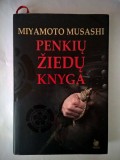 Original language:
Japanese
Original language:
Japanese Translated from: English
Authors: Musashi, Miyamoto
Translated by: Jėrinaitė, Jurgita
Full translated source bibliographical description:
Miyamoto Musashi, The Book of Five Rings, Kodansha International, Ltd., 2002
ISBN: 978-9955-700-15-9
Published in: Kaunas
Published on: 2007
Publisher: Obuolys
This book is about the way of martial arts and according to the writer Miyamoto Musashi it is the true way which warriors has to take. The book is devided into five sections: The Book of Earth, The Book of Water, The Book of Fire, The Book of Wind and The Book of Emptiness.
In The Book of Earth author defines the way of martial arts with common features and writes about his own style of martial arts which he named “two skies, one style”. At that time it was a whole new two swords style of martial arts. The author also summarises the rules which a warrior has to follow and defines a common sense about what the true way of the martial arts is and how to take it right. Author compares a warrior to a carpenter. He believes that just like a carpenter, a warrior has to take care of his weapons carefully, always keep them sharp; have a fine understanding about the way of martial arts, so if the time comes, he could become a teacher. Besides all that, the author gives a brief description about all five sections of the book.
In The Book of Water author describes his own art of sword style. Defines the gaze which has to be in martial arts, gives basics how to look right in the field and how to correctly hold a sword. He also describes six stances which are meant for warriors so they could defeat their opponents in various situations. Besides all that, the author gives instructions how to stab, slice or even decapitate correctly your opponent.
The Book of Fire is all about the fight, its’ win or loss. In this section is written that “in the way of fight the clash between two people and the encounter of ten thousand men with ten thousand men is the same”. It means that a fighting spirit can either be small or big. The author also writes about the three ways of offense which are without a doubt applied in every beginning of a fight; and how to frighten and crush your opponent. So that should happen, author describes some features about the opponent which a warrior has to know.
In The Book of Wind Musashi writes that not a single other way is a true way of martial arts. That is way in this section the author describes other styles of martial arts and their drawbacks. Defines the drawbacks of a long sword in one situation and a short sword drawbacks in another; stances and a gaze at the opponent. Besides, according to Musashi, the understanding of many sword techniques is only meant to impress a rookie. In this section is also written that you must not swing your sword with immense power, because then you will not be able to defeat you opponent if you think only about the power.
The Book of Emptiness is the shortest section of all five. This section is about the true way that a warrior takes. If a man is ignorant and does not understand the disciplines and practice of a warrior then he does not live in emptiness, because the real emptiness lies in these disciplines.
Miyamoto (Shinmen) Musashi (1584-1645) was a real prodigy of martial arts with a sword. He started his journey when he was only thirteen, when he won his first duel against a Shinto style swordsman Arima Hihei. It is said that when Musashi had a duel with Seijuro, the eyes of Musashi opened for two skies or two swords style. Throughout his all life Musashi fought in 60 duels and won them all. He also practiced Buddhism, knew about a poetry, the road of tea, “no” drama singing and he even was a carpenter. Musashi started to write his book two years before his death, when he felt the first symptoms of a disease that killed him. This book is autobiographical, meant for his apprentices as the basics of everything and for a future generations, so they could learn how to take a true way.
